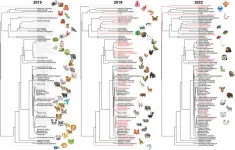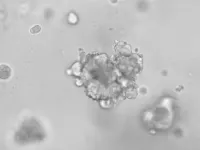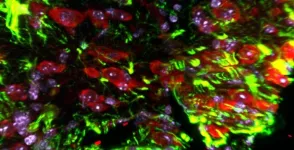(Press-News.org) The current emoji library doesn’t accurately represent the “tree of life” and the breadth of biodiversity seen in nature according to an analysis presented December 11 in the journal iScience. A team of conservation biologists categorized emojis related to nature and animals and mapped them onto the phylogenetic tree of life. They found that animals are well represented by the current emoji catalog, whereas plants, fungi, and microorganisms are poorly represented. Within the animal kingdom, vertebrates were overrepresented while arthropods were underrepresented with respect to their actual biodiversity. The researchers argue that creating a more diverse and representative emoji catalog could aid conversations around biodiversity and its conservation in the digital era.
“While the biodiversity crisis may seem distant from the online world, in our increasingly digitized society, we should not underestimate the potential of emojis to raise awareness and foster appreciation for the diversity of life on Earth,” write conservation biologists Stefano Mammola, Mattia Falaschi, and Gentile Francesco Ficetola. “The development and maintenance of diverse and inclusive emoji sets are crucial to ensure the equitable representation of the tree of life in digital communication tools and to effectively convey messages on the importance of all the organisms for the functioning of the biosphere.”
To assess the taxonomic comprehensiveness of the emoji tree of life, the team categorized all of the emojis related to nature and animals available in Emojipedia (a curated online catalog of emojis) and then compared emoji biodiversity to real-world biodiversity. They also assessed how emoji biodiversity changed between 2015 and 2022 to determine whether the emoji catalog is evolving to better represent biodiversity as more emojis are added.
Overall, the team identified emojis representing 112 distinct organisms—92 animals, 16 plants, 1 fungus (likely Amanita muscaria), and 1 microorganism (likely Escherichia coli). “Currently available emojis encompass a broad range of animal species, while plants, fungi, and microorganisms are underrepresented,” the researchers write. “Such strong taxonomic bias is in line with current societal awareness of biodiversity, which tends to prioritize animals over other taxa.”
Next, the researchers examined the biodiversity characteristics of the animal emojis in more detail. In some cases, they were able to identify individual animal species (for example, the bald eagle and giant panda emojis), while other emojis were only identifiable to the genus or family level (for example, emojis that represent ants or crocodilians).
Overall, 76% of the animal emojis represented vertebrates, 16% represented arthropods, and 4%, 2%, and 1% represented mollusks, cnidarians, and annelids, respectively. Given that there are 1,302,809 described species of arthropod and only 85,423 described species of vertebrate, this means that the current emoji catalog underrepresents arthropod biodiversity and overrepresents vertebrates.
The researchers also noted that there were no emojis representing either platyhelminths (i.e., flatworms, including tapeworms) or nematodes, despite there being more than 20,000 platyhelminth species and almost 20,000 nematode species. These biases in the emoji representation of animal biodiversity reflect known biases in biodiversity assessments and conservation analyses, including the IUCN Red List, the researchers write. The lack of underrepresented species could also be due to the criteria for judging potential emoji subjects—for something to become an emoji, it usually needs be Googled with a certain frequency, and many unrepresented organisms don’t meet this criterion.
“This rule can be problematic, as it risks hampering the extension of emojis in order to better cover the actual biodiversity of our planet,” the researchers write.
However, emoji biodiversity does appear to be increasing. In 2015, there were only emojis for 45 animal taxa, but this increased to 78 in 2019 and 92 in 2022. As well as increasing in number, animal emojis also became more representative of biodiversity over this time period. In 2015, there were only emojis representing vertebrates, arthropods, and mollusks, but annelids gained representation in 2020 with the addition of the “worm” emoji, which most likely represents an earthworm, and cnidarians gained representation in 2021 with the addition of a red coral emoji.
“This increase in phylogenetic diversity driven by less-known taxa emphasizes a positive trend of enhanced opportunities for emojifying biodiversity communication, allowing users of digital platforms to discuss a range of biodiversity-related topics and sentiments more effectively, beyond the icons depicting iconic species,” the researchers write.
Though the researchers say that having access to biodiverse emojis is crucial for online discussions of biodiversity and conservation, further research is needed to examine how nature-related emojis are used in these contexts. “Exploring the uses of nature-related emojis in the context of biodiversity communication and conservation could be a topic for further research,” the researchers write.
###
This research was supported by the Italian Ministry of University and Research and the European Union NextGenerationEU, Italian National Recovery and Resilience Plan.
iScience, Mammola et al., “Biodiversity communication in the digital era through the Emoji tree of life” https://www.cell.com/iscience/fulltext/S2589-0042(23)02646-9
iScience (@iScience_CP) is an open access journal from Cell Press that provides a platform for original research and interdisciplinary thinking in the life, physical, and earth sciences. The primary criterion for publication in iScience is a significant contribution to a relevant field combined with robust results and underlying methodology. Visit http://www.cell.com/iscience. To receive Cell Press media alerts, contact press@cell.com.
END
About The Study: High body mass index (BMI) in late adolescence was associated with early chronic kidney disease in young adulthood in this study that included 593,000 adolescents. The risk was also present in seemingly healthy individuals with high-normal BMI and before 30 years of age, and a greater risk was seen among those with severe obesity. These findings underscore the importance of mitigating adolescent obesity rates and managing risk factors for kidney disease in adolescents with high BMI.
Authors: Gilad Twig, M.D., Ph.D., of the Israel Defense Forces, Medical Corps, Tel Hashomer, Ramat Gan, Israel, is the corresponding author.
To ...
Embargoed for release: Monday, December 11, 11:00 AM ET
Key points:
In a study of 3.5 million pregnancies across four countries between 2009 and 2021, researchers observed no elevated risk of major congenital malformations, including major cardiac malformations, among infants born to pregnant women with pre-gestational type 2 diabetes who took second-line non-insulin antidiabetic medications compared with those who took insulin.
The researchers observed an increase in use of second-line non-insulin antidiabetic ...
The Organoid Group (Hubrecht Institute) and the Rare Cancers Genomics Team (IARC/WHO) found a way to grow samples of different types of neuroendocrine tumors (NETs) in the lab. While generating their new model, the researchers discovered that some pulmonary NETs need the protein EGF to be able to grow. These types of tumors may therefore be treatable using inhibitors of the EGF receptor. The results were published in Cancer Cell on 11 December 2023.
Neuroendocrine tumors
Neuroendocrine tumors (NETs) are relatively ...
BOSTON – Physician-investigators at Beth Israel Deaconess Medical Center (BIDMC) compared a chatbot’s probabilistic reasoning to that of human clinicians. The findings, published in JAMA Network Open, suggest that artificial intelligence could serve as useful clinical decision support tools for physicians.
“Humans struggle with probabilistic reasoning, the practice of making decisions based on calculating odds,” said the study’s corresponding author Adam Rodman, MD, an internal medicine physician and investigator in ...
People who have been subject to abuse are more likely to experience physical and mental health effects than previously thought, according to a new study.
In a global review and meta-analysis of evidence published in Nature Medicine today, researchers have found that there are elevated risks between intimate partner violence or childhood sexual abuse, and some health conditions including major depressive disorder, maternal miscarriage for partners, and alcohol misuse and self-harm among children.
Globally, one in three ever-partnered women have experienced ...
McGill University researchers have made a breakthrough in diagnostic technology, inventing a ‘lab on a chip’ that can be 3D-printed in just 30 minutes. The chip has the potential to make on-the-spot testing widely accessible.
As part of a recent study, the results of which were published in the journal Advanced Materials, the McGill team developed capillaric chips that act as miniature laboratories. Unlike other computer microprocessors, these chips are single-use and require no external power source—a simple paper strip suffices. They function through capillary action – ...
BEER-SHEVA, Israel, December 11, 2023 – Fairy circles, a nearly hexagonal pattern of bare-soil circular gaps in grasslands, initially observed in Namibia and later in other parts of the world, have fascinated and baffled scientists for years. Theories for their appearance range from spatial self-organization induced by scale-dependent water-vegetation feedback to pre-existing patterns of termite nests.
Prof. Ehud Meron of Ben-Gurion University of the Negev has been studying the Namibian fairy circles as a case study for understanding how ecosystems respond to water stress. He believes that all theories ...
WASHINGTON (Dec. 11, 2023)--A new study published in Proceedings of the National Academy of Sciences Nexus provides a better understanding of how the brain responds to injuries. Researchers at the George Washington University discovered that a protein called Snail plays a key role in coordinating the response of brain cells after an injury.
The study shows that after an injury to the central nervous system (CNS) a group of localized cells start to produce Snail, a transcription factor or protein that has been implicated in the repair process.The GW researchers show that changing how much Snail is produced can significantly affect whether the injury starts ...
About The Study: In participants with obesity or overweight, withdrawing tirzepatide led to substantial regain of lost weight, whereas continued treatment maintained and augmented initial weight reduction in this randomized clinical trial that included 670 adults.
Authors: Louis J. Aronne, M.D., of Weill Cornell Medicine in New York, is the corresponding author.
To access the embargoed study: Visit our For The Media website at this link https://media.jamanetwork.com/
(doi:10.1001/jama.2023.24945)
Editor’s Note: Please see the article for additional information, including other authors, author contributions and affiliations, conflict ...
Lymphatic fluid from surgical drains, which is usually tossed in the trash, is a treasure in the hands of University of Pittsburgh and Washington University School of Medicine in St. Louis researchers who found that this liquid could inform more precise treatments for patients with head and neck cancer caused by human papillomavirus (HPV).
The new study, published in Clinical Cancer Research, a journal of the American Association for Cancer Research, shows for the first time that HPV DNA in lymphatic fluid collected ...




